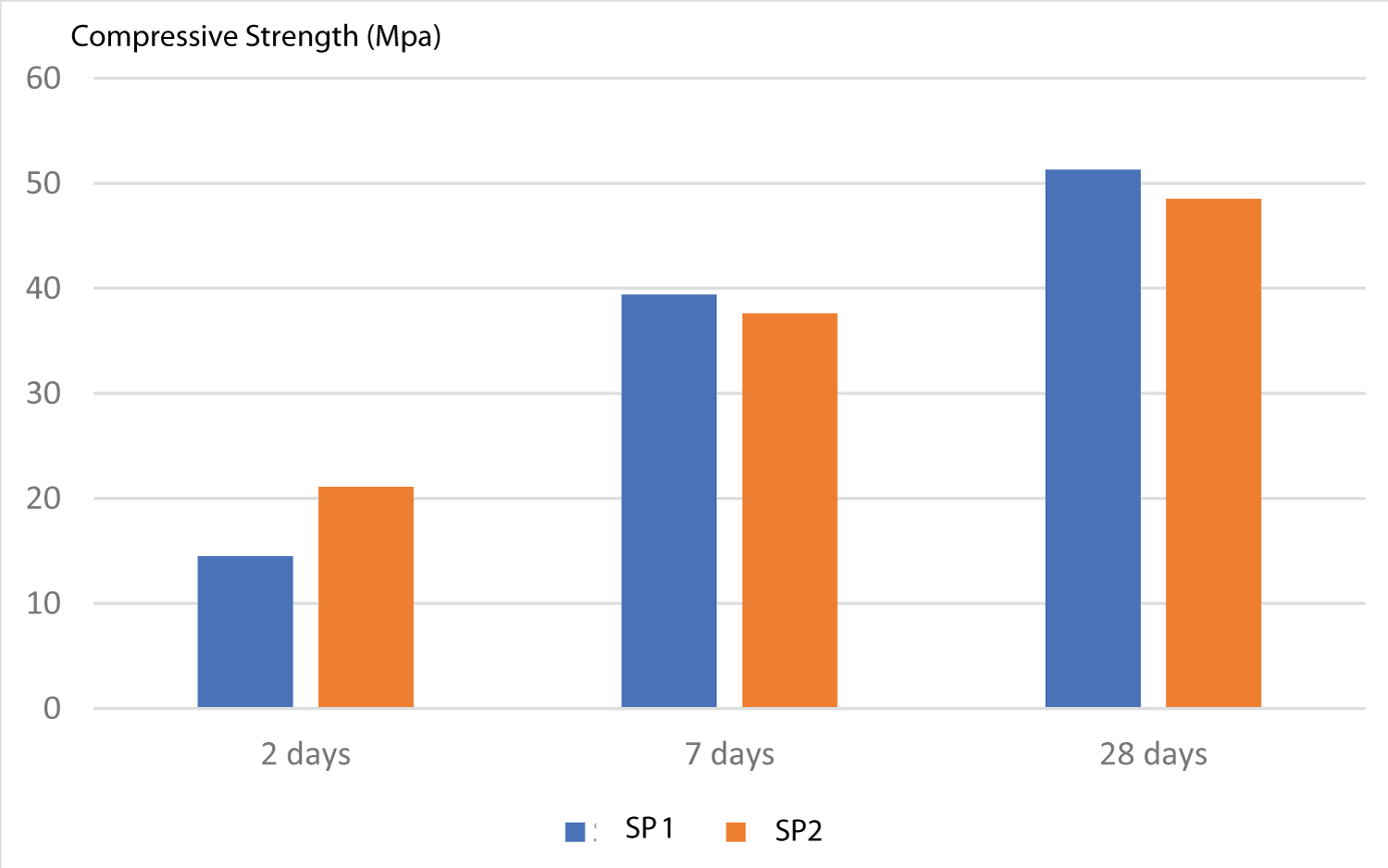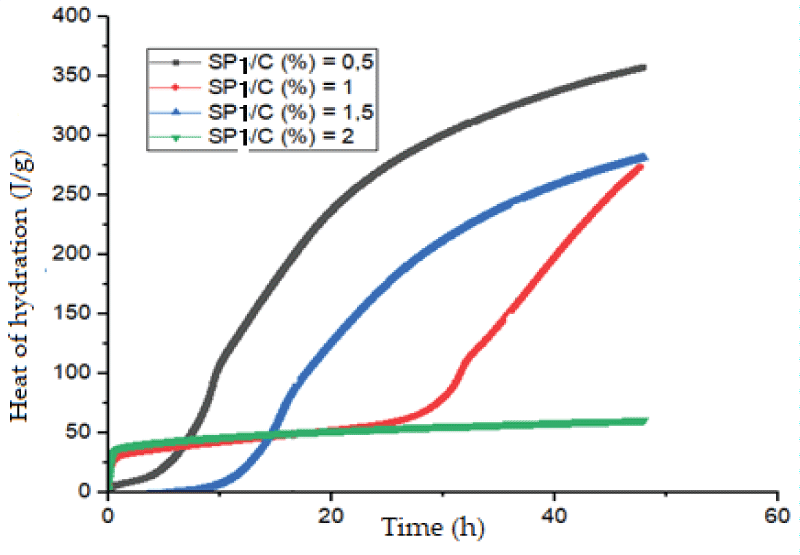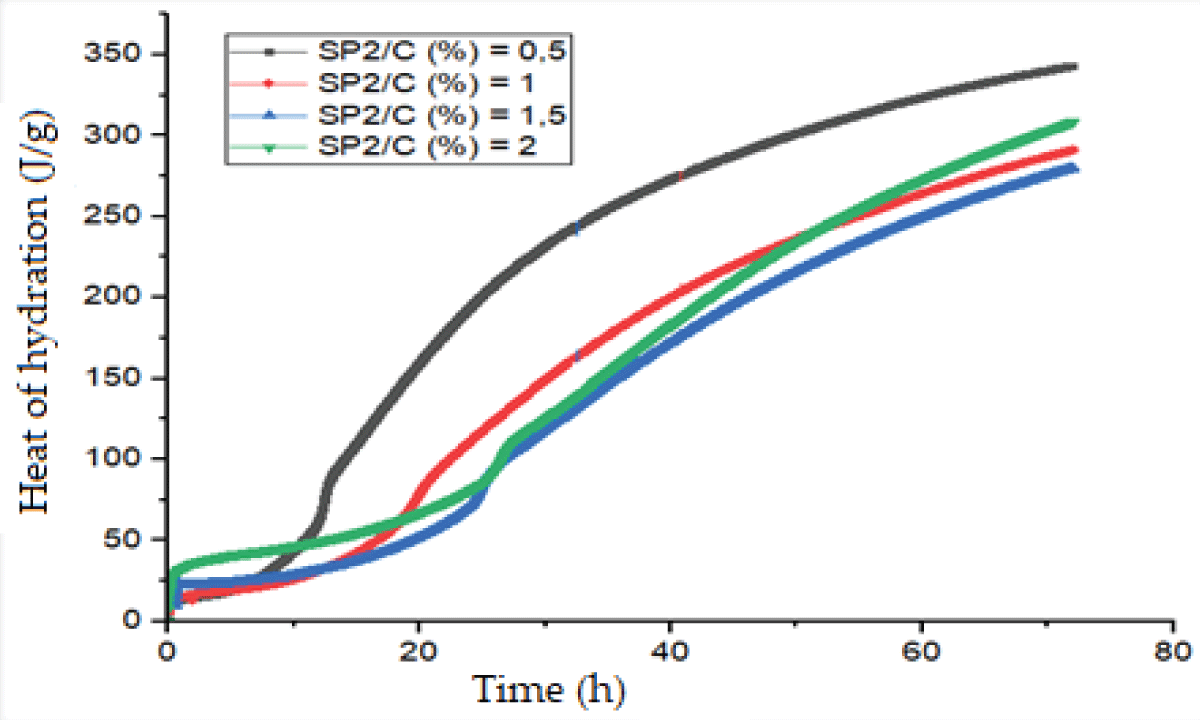
Influence of Polycarboxylate Superplasticizer on the Calorimetric and Physicomechanical Properties of Mortar
Materials Science Industrial Engineering受け取った 24 Nov 2023 受け入れられた 13 Dec 2023 オンラインで公開された 14 Dec 2023
Focusing on Biology, Medicine and Engineering ISSN: 2995-8067 | Quick Google Scholar
Previous Full Text
Kinetic Study of the Removal of Reafix Yellow B8G Dye by Boiler Ash


受け取った 24 Nov 2023 受け入れられた 13 Dec 2023 オンラインで公開された 14 Dec 2023
The use of polycarboxylate ether superplasticizer PCE in the preparation of mortars and concretes influences the hydration kinetics and the amount of total heat released. This leads to a modification of certain properties of the mortar, namely workability, calorimetry and mechanical resistance. In this study two ether polycarboxylate superplasticizers with different chemical structures were used; they were incorporated at different dosages into a standardized cement-based mortar. The objective of this work is to study the effectiveness of these superplasticizers and to select the most compatible product with cement and the most suitable for use according to the climates of the country. The impact of superplasticizers on fresh cement was studied by measuring the Marsh cone flow time and calorimetric measurement. In the hardened state, the mechanical properties were provided by measuring the compressive strength. The results show that low dosages of ether polycarboxylate superplasticizer promote grain hydration and produce more heat. On the other hand, high dosages delay the contact of the cement grains with the mixing water and cause a reduction in the final heat released and a delay in setting. The ether polycarboxylate superplasticizer with high carboxylic density gives the best mechanical resistance compressive at 7 and 28 days.
Among the most important superplasticizers currently used in the preparation of concrete, we find polycarboxylates [], preferred for their ability to improve the properties of concrete [,] and to give it better mechanical behavior due to the reduction in the necessary W/C ratio. The type of polycarboxylate used and its molecular structure influence the rheological behavior of the pastes [-]. These polymers influence the heat of hydration as well as the quantity of hydration products formed. Their dispersion effect is linked to adsorption which depends on the compatibility between superplasticizer and cement. The dispersion of grains promotes direct contact with the mixing water, which increases the quantity of hydrates formed and improves the mechanical properties of mortars or concretes.
The aim of our study is to compensate for the lack of information by analyzing the effect of two polycarboxylates of different chemical structures on the physico-mechanical and calorific properties of cement pastes.
Superplasticizer: Two types of superplasticizers produced in Algeria were used: Medaflow 30 - designated as PCE1 and Polyflow SR 5400 - designated as PCE2. The two polymers are new-generation, non-chlorinated, and are based on modified polycarboxylic ether. The characteristics of the superplasticizers, according to their technical data sheet, are presented in Table 1.
Portland cement: The cement used in this work is a composite portland cement (CEM II/ A-L 42.5 N) containing 17% clay, 80% limestone, 2% sand and 1% iron ore, produced by the company Mitidja Cements; Algeria. The chemical, mineralogical, and physical characteristics are shown in Table 2.
Compressive strength: The compressive strength was measured according to the EN 196-1 protocol. A batch of three mortar specimens was prepared with cement, water, standard sand (c:w:s = 1: 0.5: 3), and super-plasticizers (P/C = 0; 0.2; 0.4; 0.6; 0.8; 1%). After casting for 1 day, samples were demoded and cured in water for 1, 7 and 28 days. The compressive strengths of the samples were determined.
Hydration heat: A semi-adiabatic calorimeter was chosen to measure the heat of hydration of mortar samples prepared with one part cement, three parts sand, and half part water. The mixtures are adjuvanted with different dosages and types of superplasticizers. The mixtures are made with different superplasticizer contents, 0.0.5, 1, 1.5, 2%.
Figure 1 shows that SP1 gives the best mechanical compressive strength at 7 and 28 days; he is the most efficient. SP1 is a polycarboxylic ether-type superplasticizer; it is the most efficient. This copolymer has a comb structure; its main chain carries a negatively charged carboxylic group which facilitates the adsorption of the molecule on the surface of the cement particles by electrostatic interaction; The side chains contain polyethylene glycol (PEG) structures that promote dispersion of cement particles due to the steric hindrance they produce [,,]. SP1 is more efficient compared to SP2; due to its higher carboxylic charge density; the latter improves the dispersion of cement grains and promotes direct contact with the mixing water, which increases the quantity of hydrates formed and improves the mechanical properties of mortars or concretes.
Figures 2,3 illustrate the evolution of the total exothermic heat provided by different dosages of each superplasticizer. By adding superplasticizer to the mortar, the final heat decreases with increasing superplasticizer dosage; due to the dispersion of grains and the availability of water released by their deflocculation. The superplasticizers delay the contact of the cement grains with the mixing water and cause a reduction in the final heat. Polycarboxylate molecules prefer to attach to C3A and C4AF and their hydration products and delay the hydration of C3S and the formation of CSH and CH []; after the addition of 0.5% of a polycarboxylate, the formation of portlandite began after 18 hours of hydration, on the other hand for an ordinary cement without superplasticizer it began after 4 hours. Polycarboxylates delay initial hydration for a long time, since the thickness of the superplasticizer absorption layer interferes with ion diffusion, on the other hand when Ca+2 ions saturate the surface, the growth of CH eliminates the layer doubles and diffuses the silicates to the surface of the solution [].
SP1 is the most efficient; it reduces the heat of hydration to 218 J/g after 3 days due to its chemical structure. The carboxylic density and molecular weight of the superplasticizer have great effects on the dispersion performance. As the carboxylic density increases, the dispersion capacity of the SP improves [-]. PCE1 has the highest carboxylic density in the backbone and moderate molecular weight and has higher adsorption behavior on cement particles; therefore, the lowest heat of hydration. It is therefore compatible with cement.
Superplasticizers are used to improve the mechanical and calorimetric properties of cementitious systems. These anionic polymers adsorb on the surface of the cement grains and cause dispersion of the particles. Fluidity is thus obtained by the deflocculation of the cement grains and the release of the water retained in the flocculates. A consecutive reduction in the heat of hydration as a function of the superplasticizer dosage is then mentioned.
Harichane A, Benmounah A. Influence of Polycarboxylic Ether-based Superplasticizers (PCE) on the Rheological Properties of Cement Pastes. J Mater Eng Struct. 2021; 8: 325–339.
Lei L, Hirata T, Plank J. 40 years of PCE superplasticizers—History, current state-of-the-art, and an outlook. Cem Concr Res. 2022; 157: 106826.
Harichane A, SeghirNT, Niewiadomski P, Sadowski Ł. Effectiveness of the Use of Polymers in High-Performance Concrete containing Silica Fume. 2023; 15(18): 3730. https://doi.org/10.3390/polym15183730
Harichane A, Benmounah A, Plank J. Effect of Molecular Weight and Carboxylic Density of Polycarboxylates Ether Superplasticizer on Its Performance in Cement Pastes. J Mater Eng Struct. 2023; 10: 283-292.
Sha S, Wang M, Shi C, Xiao Y. Influence of the structures of Polycarboxylate superplasticizer on its performance in ce-mentbased materials-a review. Constr Build Mater. 2020; 233: 117257.
Kai K, Heng Y, Yingbin W. Effect of chemical structure on dispersity of polycarboxylate superplasticizer in cement paste. Adv Cem Res. 2019; 32: 456–464.
Chen S, Sun S, Chen X, Zhong K. Effects of core-shell polycarboxylate superplasticizer on the fluidity and hydration behavior of cement paste. Colloids and Surfaces A: Physicochemical and Engineering Aspects. 2020; 590: 124464. doi:10.1016/j.colsurfa.2020.124464.
Kong F, Pan L, Wang C, Zhang D, Xu N. Effects of polycarboxylate superplasticizers with different molecular structure on the hydration behavior of cement paste. Construction and Building Materials. 2016; 105:545-553. doi:10.1016/j.conbuildmat.2015.12.178.
Papo A, Piani L. Effect of various superplasticizers on the rheological properties of Portland cement pastes. Cement and Concrete Research. 2004; 34(11): 2097-2101. doi:10.1016/j.cemconres.2004.03.017.
Alonso MM, Palacios M, Puertas F. Compatibility between polycarboxylate-based admixtures and blended cement pastes. Cement and Concrete Composites. 2013; 35(1): 151-162. doi:10.1016/j.cemconcomp.2012.08.020.
Harichane A, Belalia F. Influence of Polycarboxylate Superplasticizer on the Calorimetric and Physicomechanical Properties of Mortar. IgMin Res. 14 Dec, 2023; 1(2): 133-135. IgMin ID: igmin128; DOI: 10.61927/igmin128; Available at: www.igminresearch.com/articles/pdf/igmin128.pdf
次のリンクを共有した人は、このコンテンツを読むことができます:
Address Correspondence:
How to cite this article:
Harichane A, Belalia F. Influence of Polycarboxylate Superplasticizer on the Calorimetric and Physicomechanical Properties of Mortar. IgMin Res. 14 Dec, 2023; 1(2): 133-135. IgMin ID: igmin128; DOI: 10.61927/igmin128; Available at: www.igminresearch.com/articles/pdf/igmin128.pdf
Copyright: © 2023 Harichane A, et al. This is an open access article distributed under the Creative Commons Attribution License, which permits unrestricted use, distribution, and reproduction in any medium, provided the original work is properly cited.
 Figure 1 : Effect of superplasticizer type on mechanical stre...
Figure 1 : Effect of superplasticizer type on mechanical stre...
 Figure 2 : Influence of the SP1 dosage on the heat of hydrati...
Figure 2 : Influence of the SP1 dosage on the heat of hydrati...
 Figure 3 : Influence of the SP2 dosage on the heat of hydrati...
Figure 3 : Influence of the SP2 dosage on the heat of hydrati...
 Table 1: Properties of the PCEs....
Table 1: Properties of the PCEs....
 Table 2: Chemical and Mineralogical composition of the ceme...
Table 2: Chemical and Mineralogical composition of the ceme...
Harichane A, Benmounah A. Influence of Polycarboxylic Ether-based Superplasticizers (PCE) on the Rheological Properties of Cement Pastes. J Mater Eng Struct. 2021; 8: 325–339.
Lei L, Hirata T, Plank J. 40 years of PCE superplasticizers—History, current state-of-the-art, and an outlook. Cem Concr Res. 2022; 157: 106826.
Harichane A, SeghirNT, Niewiadomski P, Sadowski Ł. Effectiveness of the Use of Polymers in High-Performance Concrete containing Silica Fume. 2023; 15(18): 3730. https://doi.org/10.3390/polym15183730
Harichane A, Benmounah A, Plank J. Effect of Molecular Weight and Carboxylic Density of Polycarboxylates Ether Superplasticizer on Its Performance in Cement Pastes. J Mater Eng Struct. 2023; 10: 283-292.
Sha S, Wang M, Shi C, Xiao Y. Influence of the structures of Polycarboxylate superplasticizer on its performance in ce-mentbased materials-a review. Constr Build Mater. 2020; 233: 117257.
Kai K, Heng Y, Yingbin W. Effect of chemical structure on dispersity of polycarboxylate superplasticizer in cement paste. Adv Cem Res. 2019; 32: 456–464.
Chen S, Sun S, Chen X, Zhong K. Effects of core-shell polycarboxylate superplasticizer on the fluidity and hydration behavior of cement paste. Colloids and Surfaces A: Physicochemical and Engineering Aspects. 2020; 590: 124464. doi:10.1016/j.colsurfa.2020.124464.
Kong F, Pan L, Wang C, Zhang D, Xu N. Effects of polycarboxylate superplasticizers with different molecular structure on the hydration behavior of cement paste. Construction and Building Materials. 2016; 105:545-553. doi:10.1016/j.conbuildmat.2015.12.178.
Papo A, Piani L. Effect of various superplasticizers on the rheological properties of Portland cement pastes. Cement and Concrete Research. 2004; 34(11): 2097-2101. doi:10.1016/j.cemconres.2004.03.017.
Alonso MM, Palacios M, Puertas F. Compatibility between polycarboxylate-based admixtures and blended cement pastes. Cement and Concrete Composites. 2013; 35(1): 151-162. doi:10.1016/j.cemconcomp.2012.08.020.